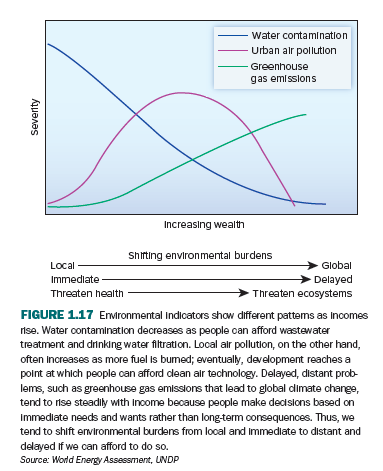Water contamination Urban alr pollution Greenhouse gas emisslons Increasing wealth Shirting environmental burdens Local Global > Delayed Threaten ecosystems Immediate Threaten health FIGURE 1.17 Ervironmental Indicators show different pattems as Incomes nse. Water oontamination decreases as people can afford wastewater treatment and drinking water filtration. Local alr pollution, on the other hand, often Increases as more fuel is bumed; eventually, development reaches a polnt at which people can afford dean alr technology. Delayed, distant prob- lems, such as greenhouse gas emissions that lead to global dimate change, tend to rise steadily with Income because people make decisions based on Immediate needs and wants rather than long-term oonsequences. Thus, we tend to shift environmental burdens from local and immediate to distant and delayed if we can afford to do so. Source: World Energy Assessment, LNDP Seventy
Water contamination Urban alr pollution Greenhouse gas emisslons Increasing wealth Shirting environmental burdens Local Global > Delayed Threaten ecosystems Immediate Threaten health FIGURE 1.17 Ervironmental Indicators show different pattems as Incomes nse. Water oontamination decreases as people can afford wastewater treatment and drinking water filtration. Local alr pollution, on the other hand, often Increases as more fuel is bumed; eventually, development reaches a polnt at which people can afford dean alr technology. Delayed, distant prob- lems, such as greenhouse gas emissions that lead to global dimate change, tend to rise steadily with Income because people make decisions based on Immediate needs and wants rather than long-term oonsequences. Thus, we tend to shift environmental burdens from local and immediate to distant and delayed if we can afford to do so. Source: World Energy Assessment, LNDP Seventy
Micro Economics For Today
10th Edition
ISBN:9781337613064
Author:Tucker, Irvin B.
Publisher:Tucker, Irvin B.
Chapter14: Environmental Economics
Section: Chapter Questions
Problem 17SQ
Related questions
Question
Describe in your own words how increasing wealth affects water contamination, air pollution, and greenhouse gas emissions. Why might greenhouse gas emissions rise? Describe and explain the air pollution curve.

Transcribed Image Text:Water contamination
Urban alr pollution
Greenhouse
gas emisslons
Increasing wealth
Shirting environmental burdens
Local
Global
> Delayed
Threaten ecosystems
Immediate
Threaten health
FIGURE 1.17 Ervironmental Indicators show different pattems as Incomes
nse. Water oontamination decreases as people can afford wastewater
treatment and drinking water filtration. Local alr pollution, on the other hand,
often Increases as more fuel is bumed; eventually, development reaches a
polnt at which people can afford dean alr technology. Delayed, distant prob-
lems, such as greenhouse gas emissions that lead to global dimate change,
tend to rise steadily with Income because people make decisions based on
Immediate needs and wants rather than long-term oonsequences. Thus, we
tend to shift environmental burdens from local and immediate to distant and
delayed if we can afford to do so.
Source: World Energy Assessment, LNDP
Seventy
Expert Solution
This question has been solved!
Explore an expertly crafted, step-by-step solution for a thorough understanding of key concepts.
Step by step
Solved in 3 steps

Knowledge Booster
Learn more about
Need a deep-dive on the concept behind this application? Look no further. Learn more about this topic, economics and related others by exploring similar questions and additional content below.Recommended textbooks for you



Principles of Economics 2e
Economics
ISBN:
9781947172364
Author:
Steven A. Greenlaw; David Shapiro
Publisher:
OpenStax



Principles of Economics 2e
Economics
ISBN:
9781947172364
Author:
Steven A. Greenlaw; David Shapiro
Publisher:
OpenStax